Seolleung Jeongneung Royal Tombs: Joseon Dynasty
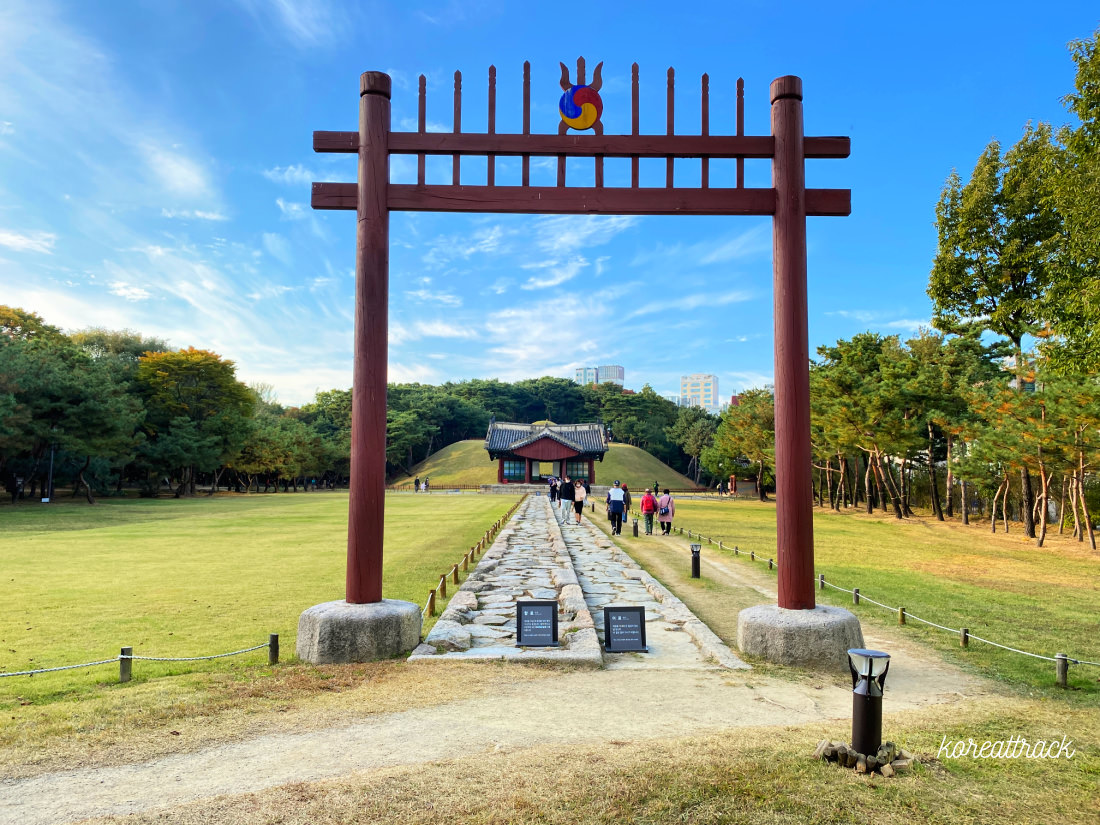 Gate to the Jeongjeung of King Jungjong's shrine and the royal tomb
Gate to the Jeongjeung of King Jungjong's shrine and the royal tombSeolleung Jeongneung Royal Tombs
Seolleung Jeongneung Royal Tombs are tombs of the Joseon Dynasty, two kings and a queen. There are three separate tombs: King Seongjong, King Jungjong, and Queen Jeonghyeon.
Located in Gangnam District, it is a very convenient historical site to explore in addition to your sightseeing or shopping at this opulent and famous district of Seoul.
I confess that I have been living here for many years now, but it's embarrassing to say that it is my first time exploring this incredible place.
Interestingly, I know some Korean friends who have not been here either! Anyway, let me continue...
It is close to the Seolleung subway station making it all the more accessible to efficient public transportation in Seoul.
What to expect and do?
- You can stroll a part or the whole of the royal tombs' forested park area in the middle of the high-story apartments and business building.
- You can do photography with the royal background of the kings or queens tombs;
- You can rest on benches facing the verdant trees, grass, or flower gardens (depending on the season)
- You can climb up near the tombs to examine the mound tombs, statues of guardians, and symbolic animals.
- You can also visit the Royal Tombs History Center.
- And you will encounter a 500-year old Gingko tree standing tall and proud next to the tomb keeper's house.
Seolleung - Tomb of King Seongjong
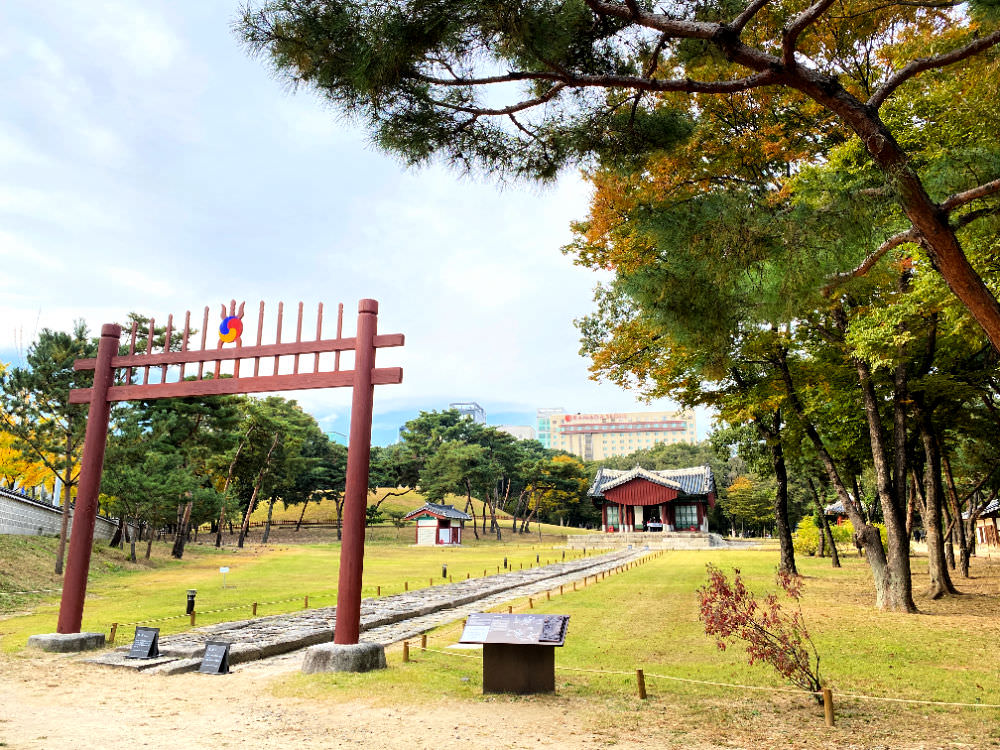 Entrance gate of Jeongneung
Entrance gate of JeongneungAt the entrance gate of King Seongjong's Seolleung (tomb area), the following description is inscribed...
This is the tomb of King Seongjong (1457-1494, r.1469-1494), the ninth monarch fo the Joseon Dynasty, and his third consort Queen Jeongjyeon of the Yun clan (1462-1530). Seen from the ceremonial pavilion, the king's burial mound is on the left hill and the queen's on the right.
King Seongjong, the son of posthumous King Deokjong and Queen Sohye (later Queen Dowager Insu), ascended the throne in 1468 at the age of 13. During his reign, major projects such as publication of Gyeongguk daejeon (national code of laws) and the Five Rites of State (Gukje Orye) were completed, and the legal system for Confucianism-based rule was amended.
The style of Seongjong's tomb followed the protocol set out in Five Rites of State and hence features retaining stones around the burial mound and a stone railing, while Queen Jeonghyeon's burial mound has a stone railing but no retaining stones.
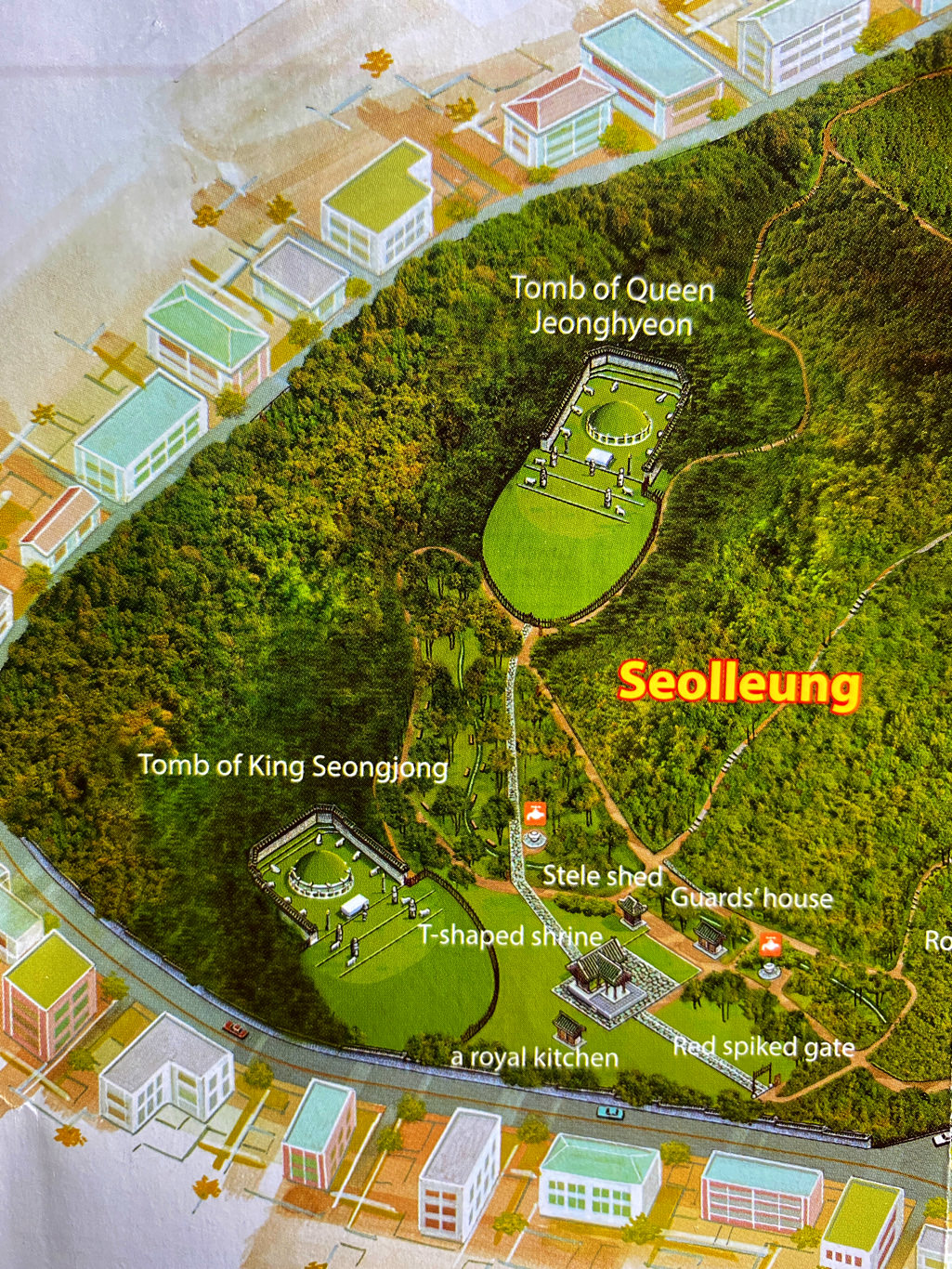 Map of Seolleung - King Seongjong and Queen Jeongjhyeon's tombs
Map of Seolleung - King Seongjong and Queen Jeongjhyeon's tombs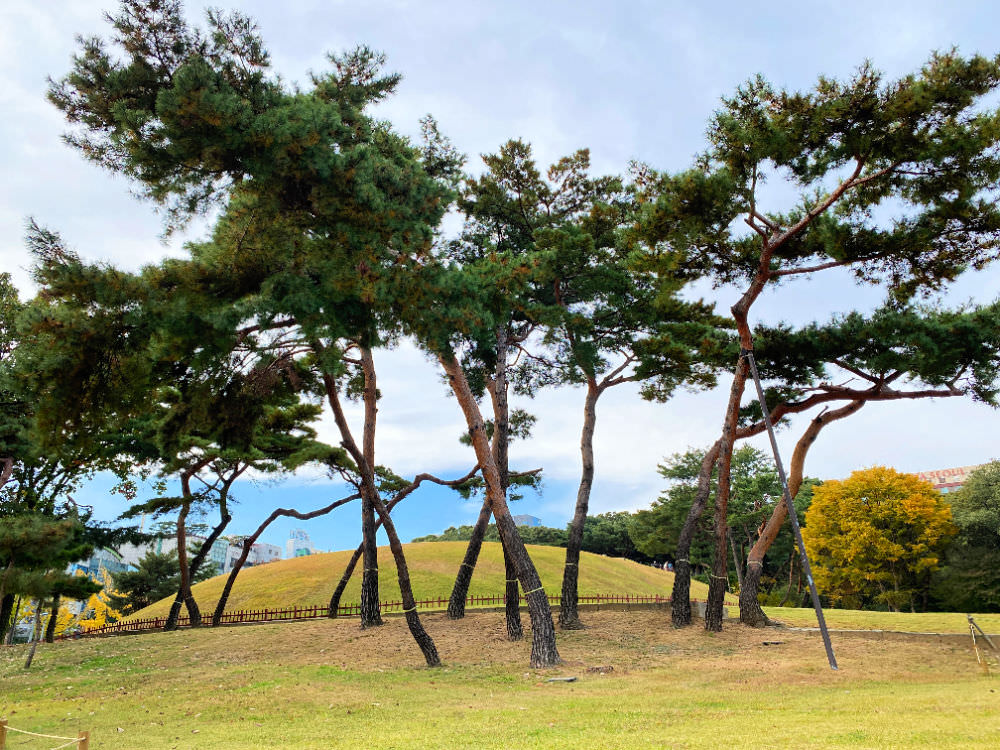 A view of King Seongjong's mound behind the pine trees
A view of King Seongjong's mound behind the pine trees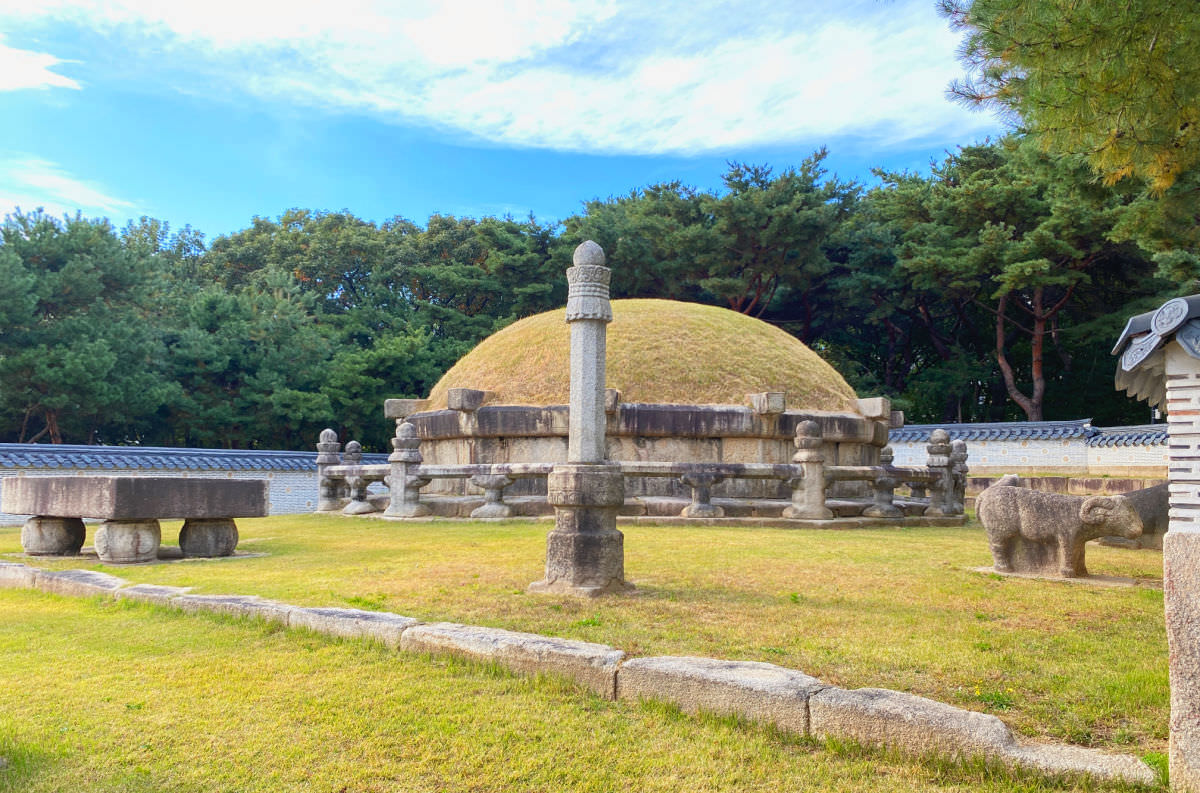 Tomb of King Seongjong with its facilities based on the requirements of Confucian practice
Tomb of King Seongjong with its facilities based on the requirements of Confucian practice
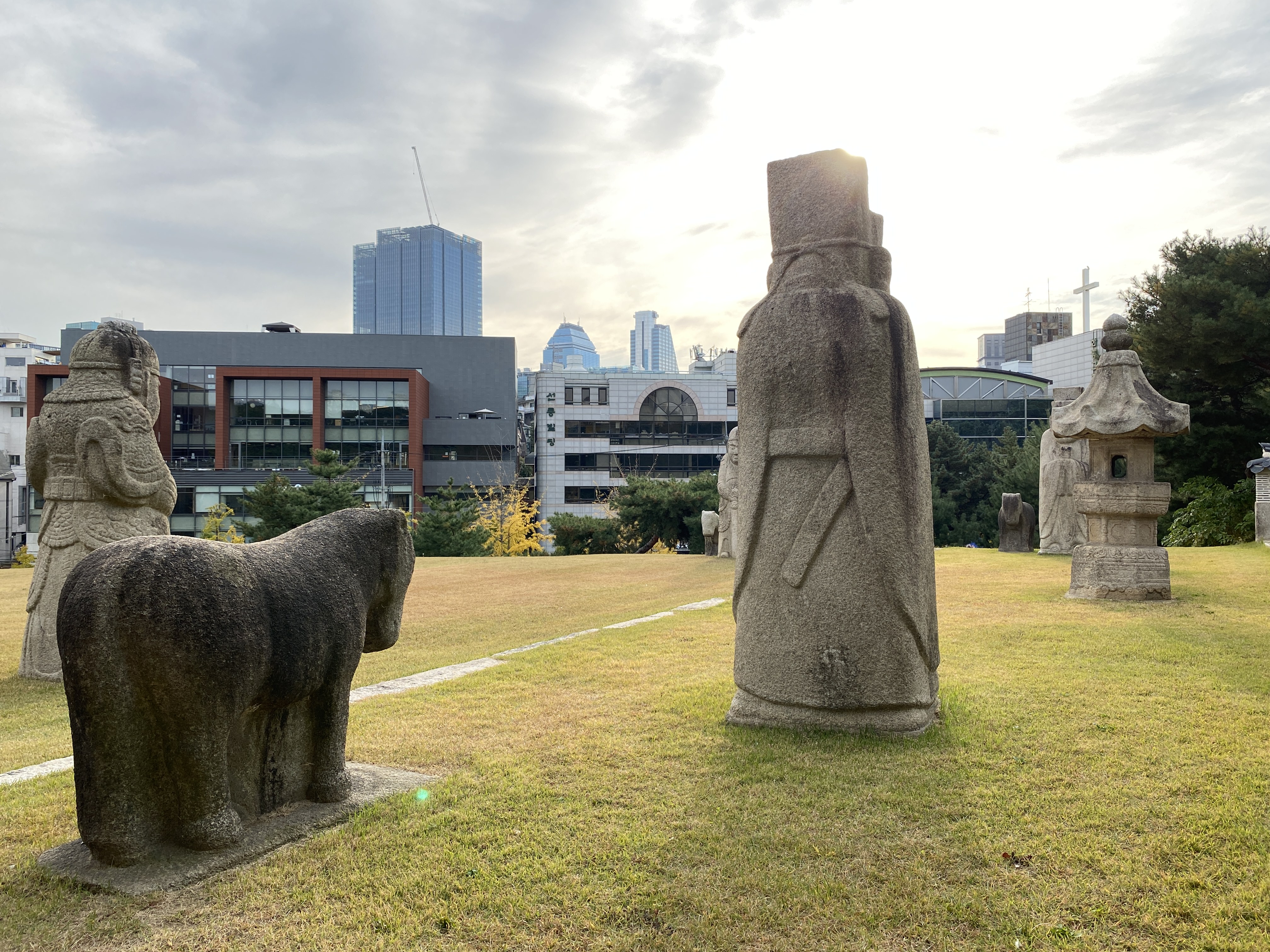 An official, a military, animal stone sculpted figures guarding the King's tomb An official, a military, animal stone sculpted figures guarding the King's tomb |
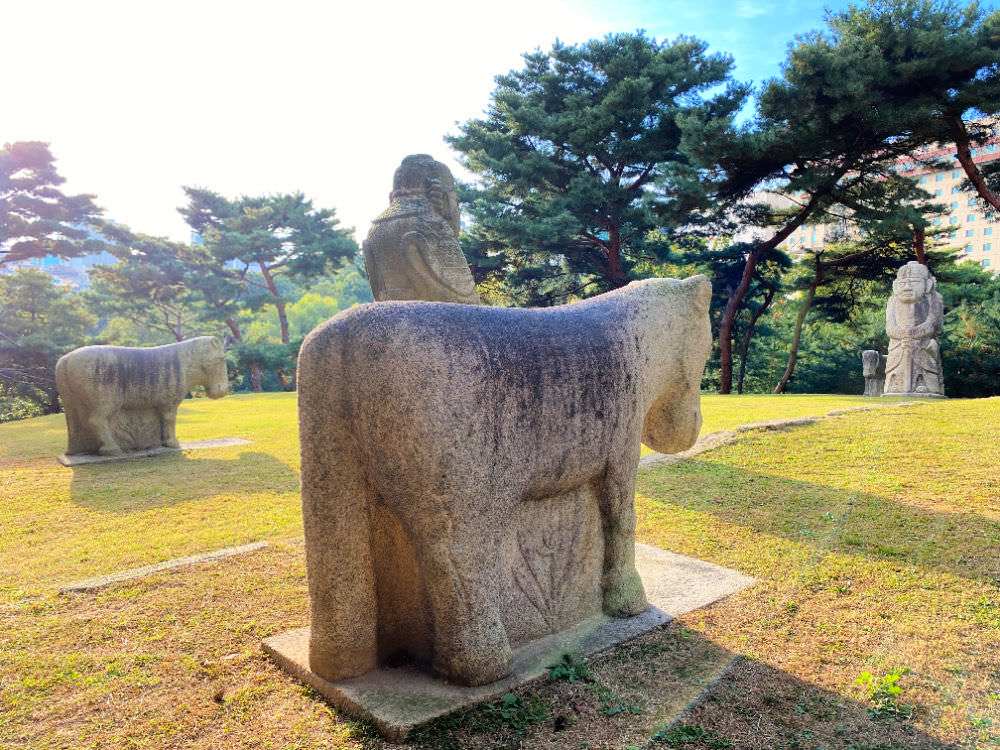 An official, a military, animal stone sculpted figures guarding the King's tomb An official, a military, animal stone sculpted figures guarding the King's tomb |
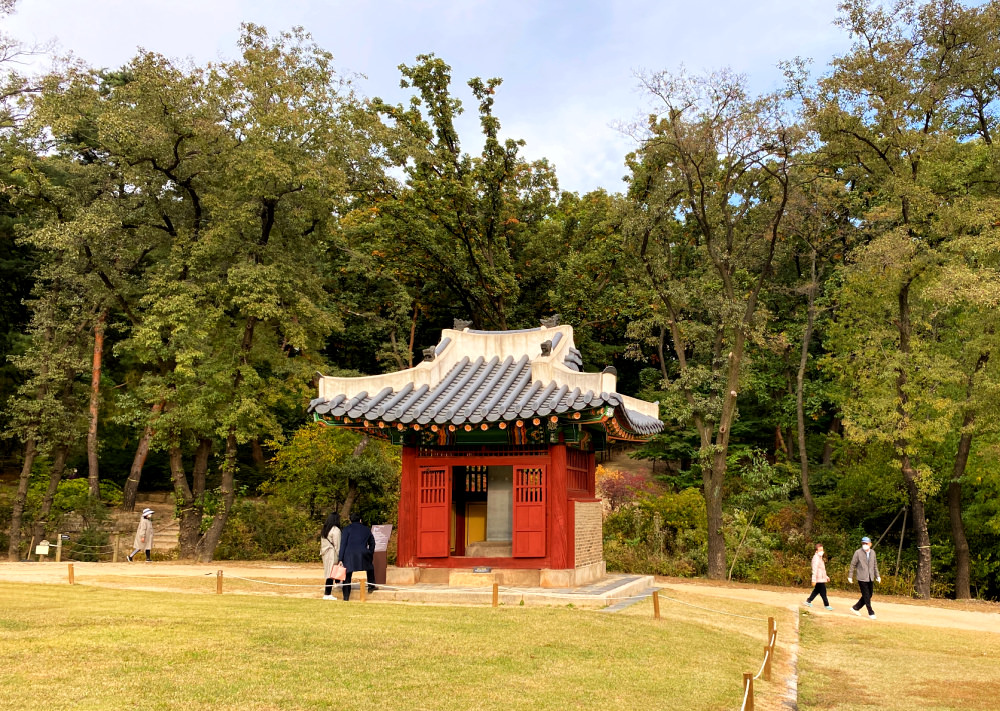 A stone stele inscribed with the achievements of King Seongjeong under the roof
A stone stele inscribed with the achievements of King Seongjeong under the roof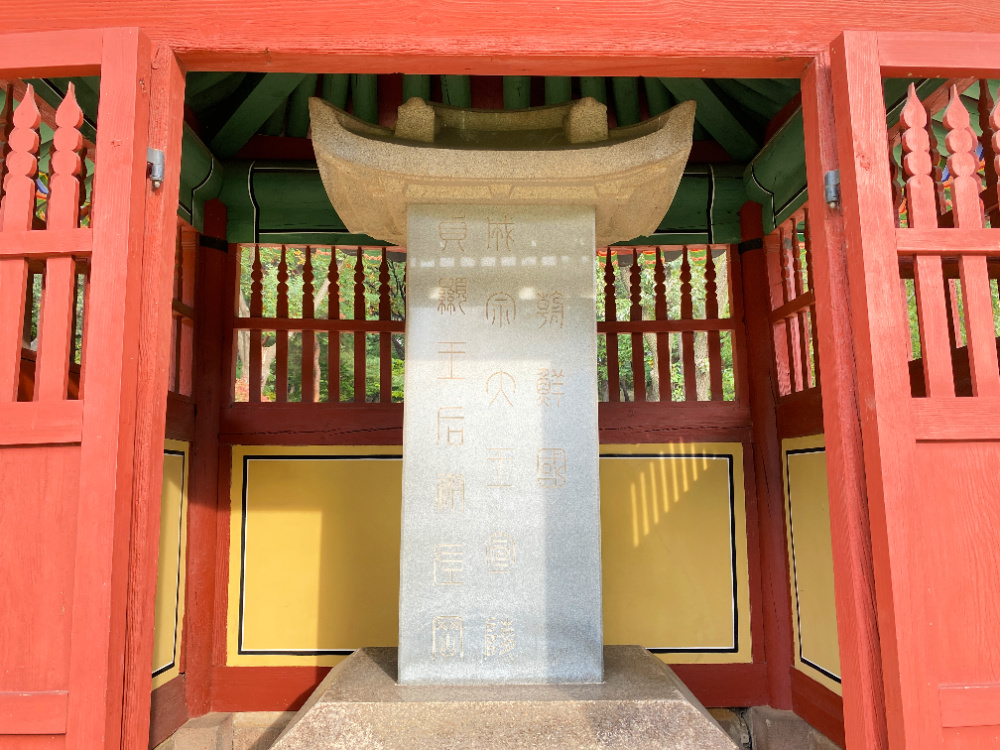 Stone stele inscribed with the achievements of King Seongjong during his reign
Stone stele inscribed with the achievements of King Seongjong during his reignJeongneung - Tomb of King Jungjong
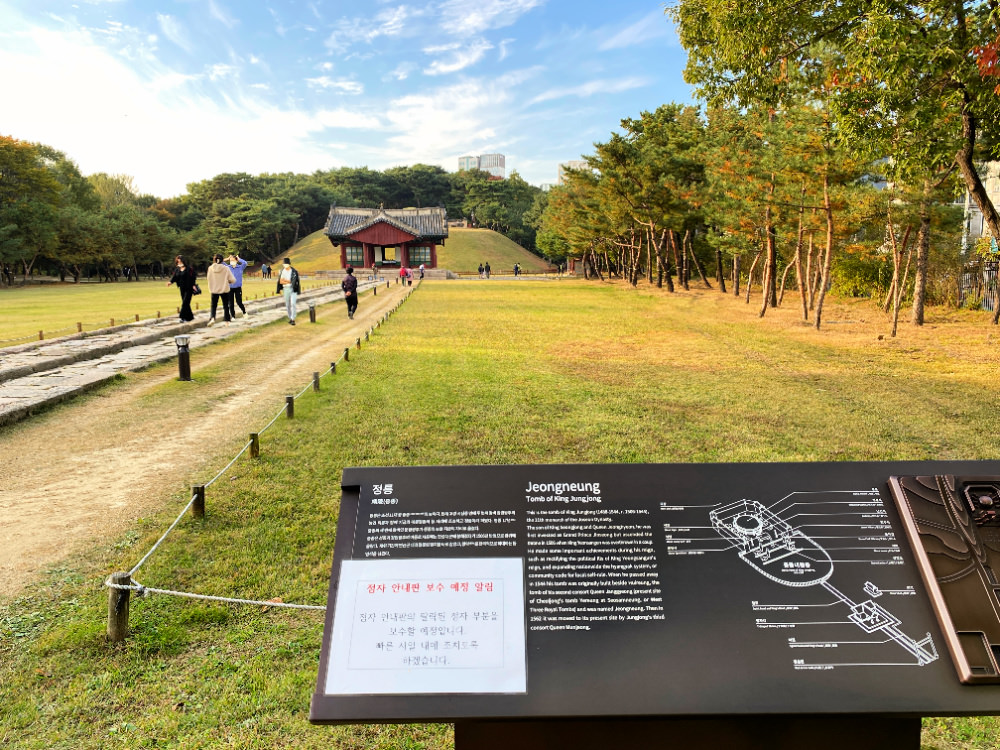 Entrance gate of King Jungjong's tomb area
Entrance gate of King Jungjong's tomb areaThe following is inscribed on the board at the entrance gate of King Jungjong's tomb...
This is the tomb of King Jungjong (1488-1544, r.1506-1544), the 11th monarch fo the Joseon Dynasty. The son of King Seongjong and Queen Jeonghyeon, hea was first invested as Grand Prince Jinseong but ascended the throne in 1506 when King Yeonsangun was overthrown in a coup.
He made some important achievements during his reign, such as rectifying the political ills of King Yeongsnagun's reign, and expanding nationwide the hyangyak system, or community code for local self-rule.
When he passed away in 1544 his tomb was originally built beside Huireung, the tomb of his second consort Queen Janggyeong (present site of Cheoljong's tomb Yerueng at Seosamneung, or West Three Royal Tombs) and was named Jeongneung.
Then in 1562 it was moved to its present site by Jungjong's third consort Queen Munjeong.
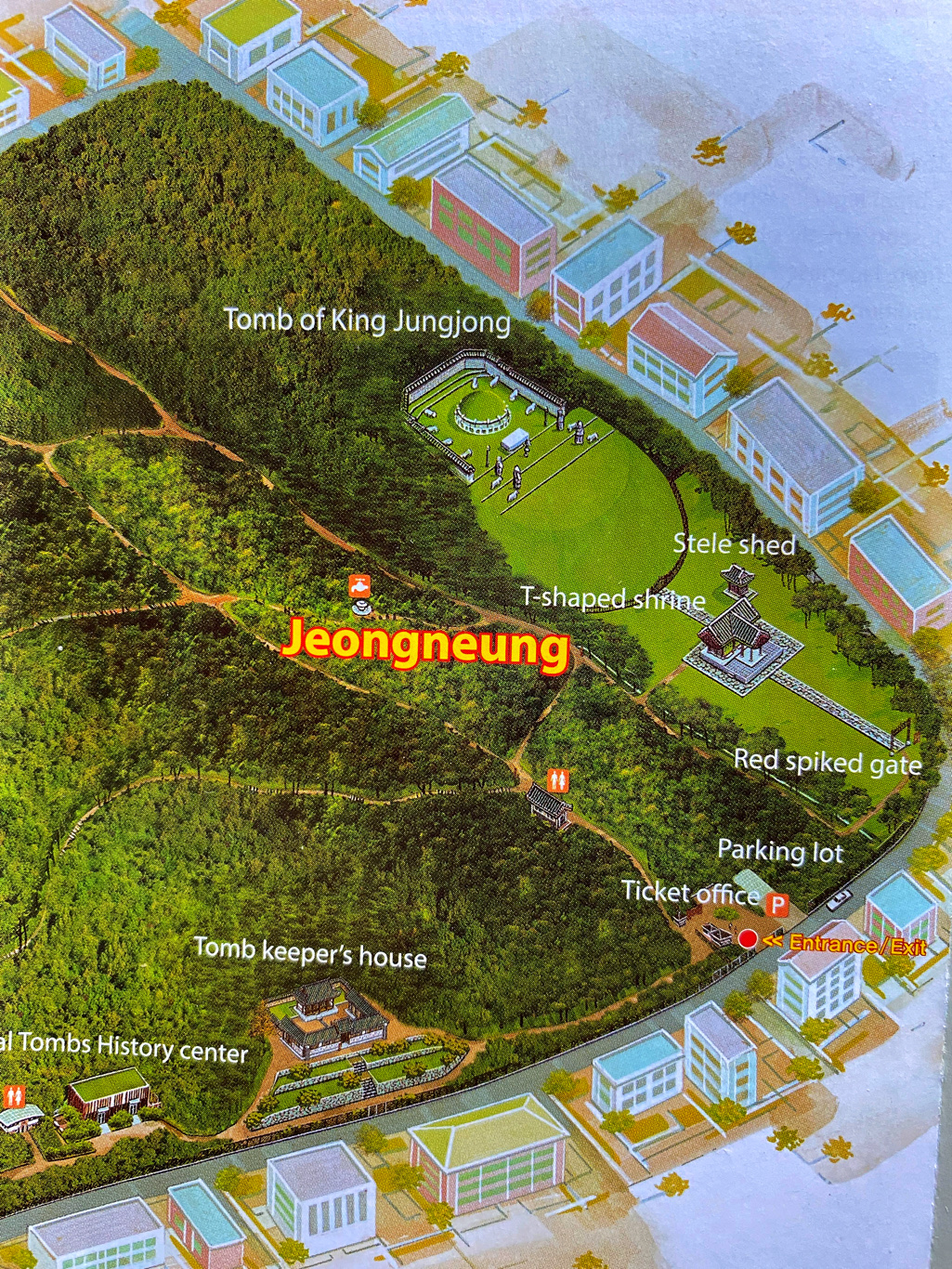 Map of King Jungjong's tomb - Jeongneung
Map of King Jungjong's tomb - Jeongneung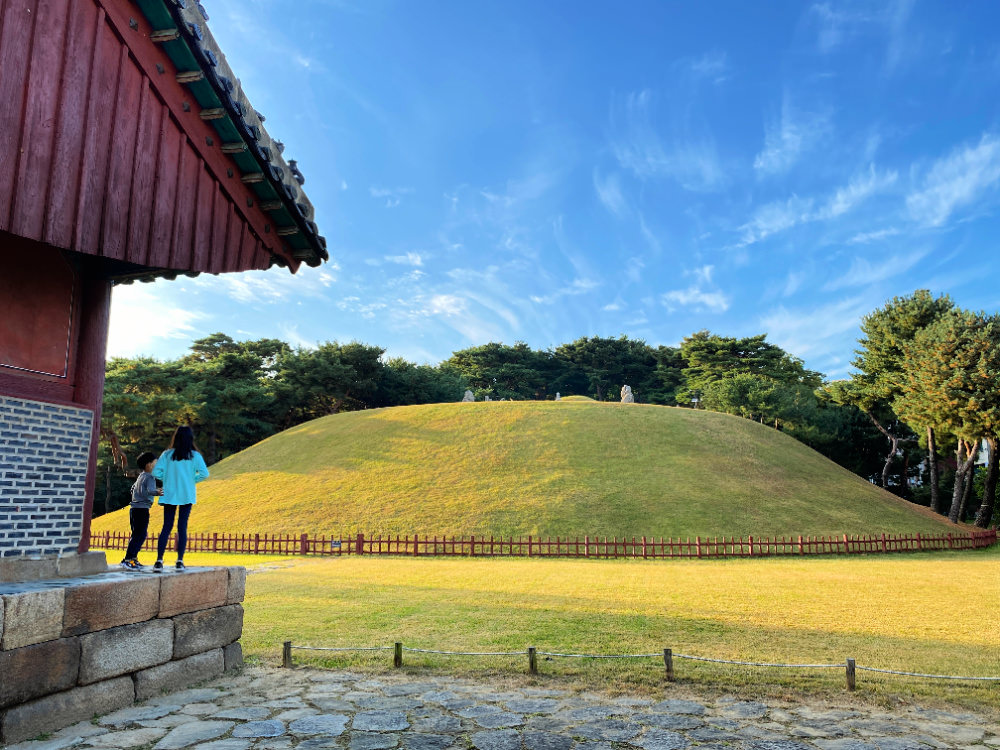 Seolleung Jeongneung Royal Tombs [King Jungjong's Tomb]
Seolleung Jeongneung Royal Tombs [King Jungjong's Tomb]
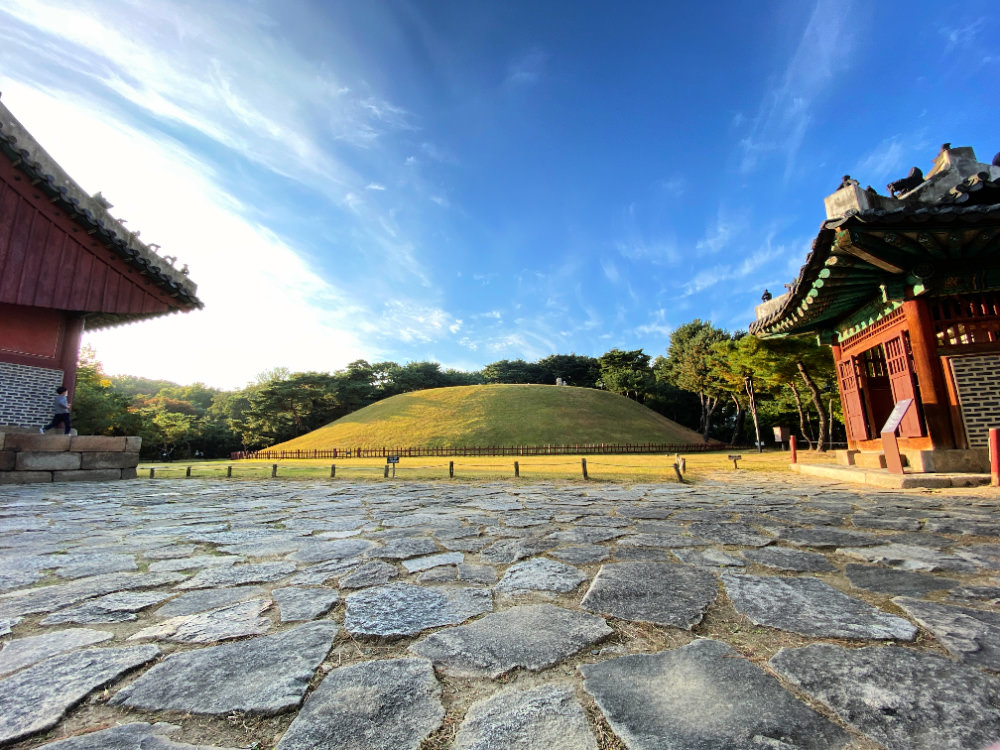 Tomb of King Jungjong Tomb of King Jungjong |
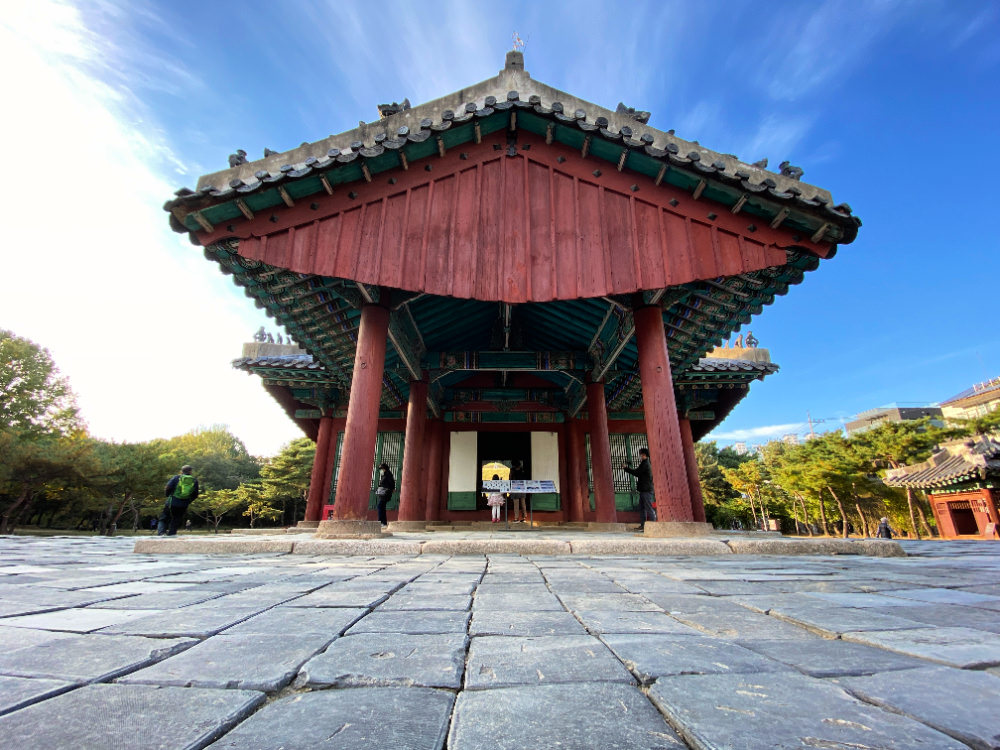 Shrine at King Jungjong's tomb Shrine at King Jungjong's tomb |
Seolleung Jeongneung Royal Tombs of the Joseon Dynasty
The Seolleung Jeongneung Royal Tombs site is a three-royal tombs historic site enlisted at the UNESCO World Heritage. Let us dissect the three royal tombs of the Joseon Dynasty royals in this section.
Seolleung of King Seongjong
The Seolleung of this park belongs to the tomb of King Seongjong and Queen Jeonghyeon. King Seongjeong (1457-1494) is the ninth rule of the Joseon Dynasty. His third consort was Queen Jeonghyeon (1462-1530).
Seolleung was positioned in such a way that the king's mound sits in the west, and the queen's in the east, and the Hongsalmun (Red-spiked Gate) and Jeongjagak (T-shaped shrine) stands south in the middle of the two mound tombs. These two tombs are located along the new road, Tehran Road, in the Gangnam area.
Seongjong was the second son of Crown Prince Uigyeong (Honorary King Deokjong), who died at a very young age. Seongjong became the king at 12 with the backing from his father-in-law, Han Myeong-hoe, and his grandmother, Queen Jeonghui, until he died when he was 37 years old.
During his rule, he completed the Grand Code for State 'Gyeonggukdaejeon' [Grand Code of State Administration], which became the primary statute of the Joseon Dynasty.
The Dynasty people enjoyed peace and progress in various fields, including politics, culture, and economy. In fact, the first character of the King's name 'seong' means 'accomplishment'.
King Seongjeong did not have any child from his first wife, Queen Gonghye, the daughter of powerful senior minister Hang Myeong-hoe, as she died prematurely.
The King's second consort, Lady Yun, was deposed but left him a sone who later became King Yeonsangun, who was also deposed later on.
Then Queen Jeonghyeon, the King's third consort, later became a queen from being a former concubine after Lady Yun was deposed. Jeonghyeon's son, Prince Jinseong, became a king taking over his half brother's throne, King Yeonsangun, who was ejected.
You will find stone sculptures, civil and military officials, animals, and other objects, around King Seongjong's tomb, which symbolize his strong and sovereign power.
Jeongneung of King Jungjong
The Jeongneung of the part of the park is the tomb of King Jungjong. This tomb is only for King Jungjong, who lived in 1488-1544, the second son of King Seongjong.
King Jungjong succeeded King Yeonsangun, his elder and half-brother's throne, in 1506, deposed in a coup de 'tat.
Although he had weak support, he tried to implement reform with the help of neo-Confucian literati. However, his efforts all the more confused people as Jo Gwang-jo, the king's top adviser, pursued a more radical policy.
When King Jungjong died, he was buried near his second consort, Queen Janggyeong. However, in 1562, his third consort, Queen Munjeong, thought it was proper for him to be moved to the present location.
Queen Munjeong wished to be buried beside King Jungjong, but the king's tomb was often flooded. Thus the queen was not buried beside the king; instead, she was also buried alone in Taereung, Seoul.
Queen Dangyeong, King Jungjong's first consort, was deposed by a coup de tat leading to Jungjong's ascension to power. However, Dangyeong returned to power during King Yeongjo's reign and was buried in Olleung in Yangju, Gyeonggi Province.
At Jeongneung, you will see stone sculptures of civil and military officials who have damages incurred during the Japanese invasion in 1592. (See the photos).
More About King Songjong & Queen Jeonghyeon
Prince Jaeulsan, who became King Seongjong, was far from becoming a king when his uncle King Yejong came to power, succeeding his father, King Sejo.
However, when King Yejong dies after fourteen months of reign, Seongjong was put to the throne by-passing King Yejong's son (Prince Je-an) and Seongjong's older brother (Prince Wolsan).
Seongjong became king when he was only 13 years old with the support of Seongjong's father-in-law (Han Myeong-hoe), grandmother, and his mother.
Due to his young age and having no training for kingship, King Seongjong had to study very hard to learn whatever he needed to learn about ruling the kingdom. He started directly serving as a king at twenty years old, seven years after he was enthroned.
The young King Seongjong was known to be a very diligent student and rarely missed the royal classes and policy discussions.
He
even attended three to four lectures a day, which worried his
grandmother, Queen Jeonghui, and others for his health (as people in the
old days die so early). By the way, he died when he was 37 years old.
Due
to his hard work and tenacity, Seongjong completed and promulgated the
Grand Code of State Administration, the Special Counselors Office's
installation, and the engagement of the Neo-Confucian literati.
Aside from being a bookworm, he loved poetry, hunting, outdoor activities, and other mundane pursuits.
As a poet himself, King Seongjong wrote a poem for her grandmother Queen Jeonghui wishing for her long and healthy life:
I came here today to throw a banquet for my grandmother
In my mind, I wish to do more than the filial son Lao Lai-Tzu
I drank wine wishing her long life, and even got drunk
But I will never be able to return her kindness
I will pay respects to her morning and evening for a long time to come.
[December 13, 1489, from the Annals of King Seongjong]
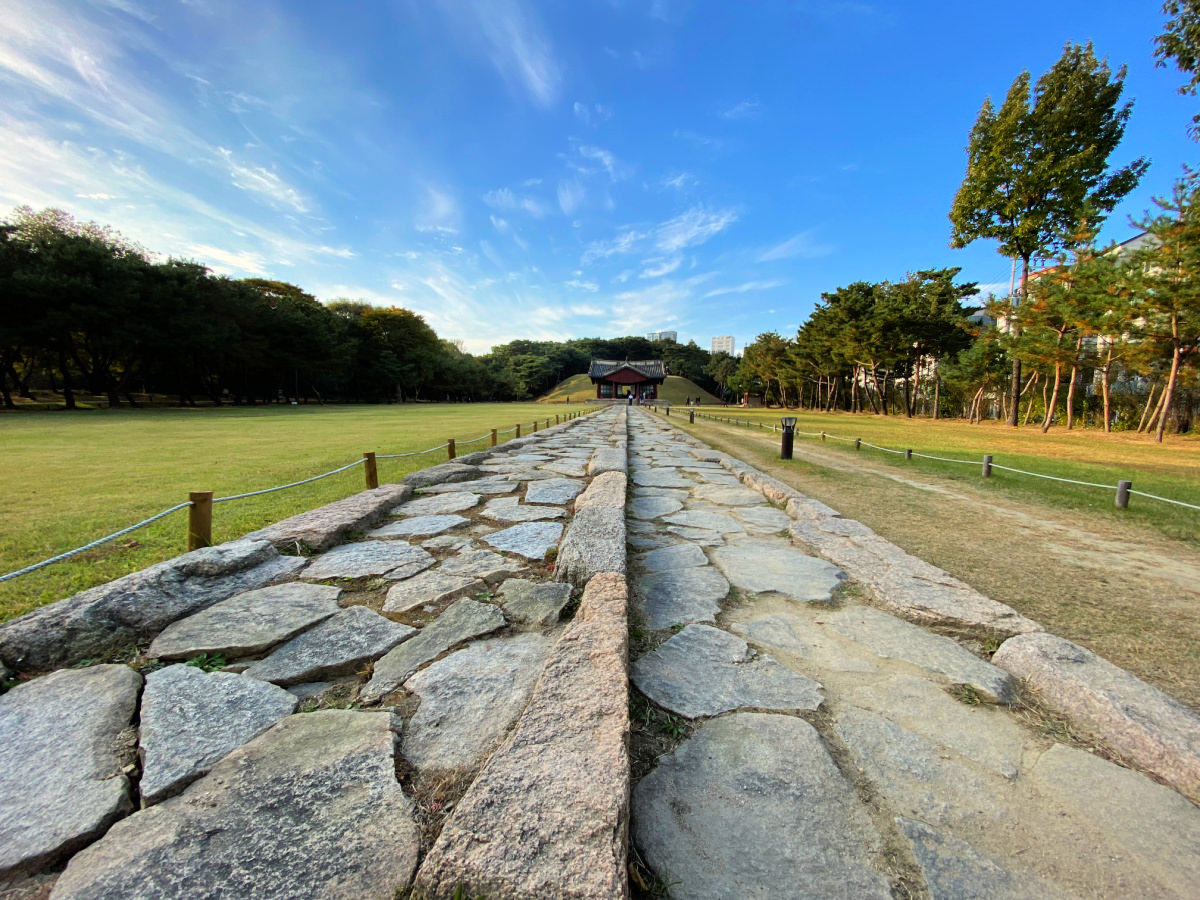 Jeongneung of King Jungjong's tomb
Jeongneung of King Jungjong's tomb Entrance area at King Jungjong's tomb area
Entrance area at King Jungjong's tomb areaSome forbidden Activities
There are signs and instructions that stepping on the king's pathway is not allowed.
Also, eating food inside is prohibited but drinking any liquids (except alcohol) are allowed.
Quick Information History and Memorial Rites
You can read the below brief information about the kings and queen buried in this UNESCO site.
Historical Background
King Seongjeong was interred at Seolleung in 1495.
King Jungjong's tomb was moved to the present tomb's location in 1562 from its original site in Huireung, where the grave of his second consort Queen Janggyeong is located.
Memorial Rites
- The memorial rite for King Seongjong at Seolleung is being held every December 24 on the lunar calendar.
- While the memorial rite for Queen Jeonghyeon is held on August 22 annually on the lunar calendar.
- For King Jungjong's memorial in Jeongneung site, the rite is being held every December 9 every year.
If you are in Korea on any of those dates, it would be a good experience to witness such an event. You will see the traditional colorful clothes and witness the royal rites of the dead royals.
Nearby Facilities
Since Seolleung Jeongneung Royal Tombs is conveniently sitting amidst Gangnam's affluent district, you can quickly find facilities and services you need without moving far from it.
As you can expect, you can find...
- restaurants and cafes
- convenience stores and shops
- fast-food chains
- bakeries, donuts shops, etc.
- Hotels, Motels, B&Bs, etc.
- subway station, buses, taxis, bicycles
- maps, tourism centers, travel centers, etc.
- washrooms are available inside the park
Opening Time
March to October
During these months, you can purchase a ticket (adult: 1,000 Won; youth: 7-18 years old) from 6 AM until 8 PM as it closes at 9 PM.
November to January
During these months, you can buy a ticket from 6:30 AM until 4:30 PM only. It closes at 5:30 PM.
In February, it opens from 6 AM and closes at 6 PM.
Entrance Fees
As you have guessed, admission fees vary according to age and number of guests. Please, note that the following rates could change for various reasons.
Adult (from 18 and above): 1,000 Won; Adult Group (10 persons and above): 800 Won
Youth (7 to 18 years old): 500 Won; Youth Group (10 persons or more): 400 Won
Children (under 6 years old) and senior citizens (65 years and above) can enter for FREE.
Finding Seolleung Jeongneung Royal Tombs
gYou can get near the park via public transportation, which is very efficient. Here's how...
By Seoul Subway
Take any subway line that will bring you to Seolleung Station Line 2. Then come out from Exit 10 and walk for about 6 minutes to reach the royal tombs park.
Second, you can take the Bundang Subway line and get to Seongjongneung Station. From this station, come out from Exit 3 and walk for more than ten minutes to reach the tombs park.
Third, you can take a subway and get off at Samsung Central Station Line 9. Come out from Exit 6 and walk for around 12 minutes to find Seolleung Jeongneung Royal Tombs.
By Bus
Depending on the available bus from your hotel or residence, you can take the public bus with the following numbers: 472, 6411, 4412, 3426, 146, 333, 341, 360, 740, or Gangnam07.
By Private Car
You can drive taking the Teheran-ro (road), then continue to Seolleung Station Junction, and it is 300 meters ahead towards Gangnam-gu District Office.
Phone: +82-2-568-1291
Washrooms are available for public use.
Get Exciting Activities
Book one of our exciting activities today to experience the thrill of a lifetime! Take advantage of this opportunity and secure your spot in advance.
Hotel Map Guide
Find your affordable, accessible, and comfortable hotel in Seoul at Agoda.Com. See the hotel map below...
Hotel Booking Guide
Find affordable and amazing hotels on Agoda.com using the search box below. Book now to enjoy great discounts and save!
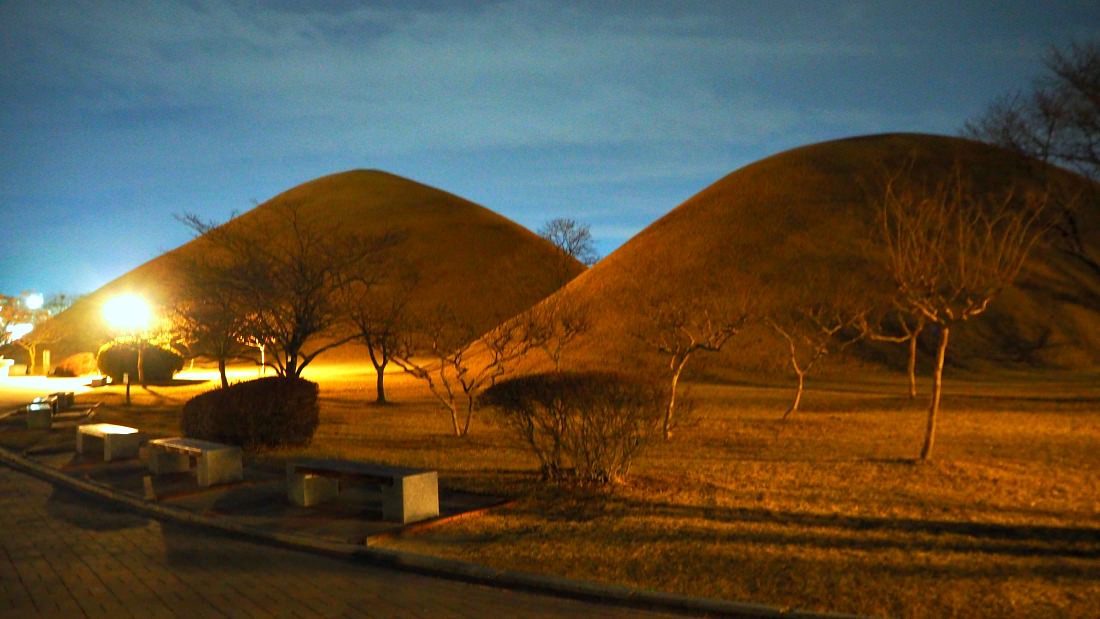





New! Comments
What do you think about this page? Leave me a comment in the box below.